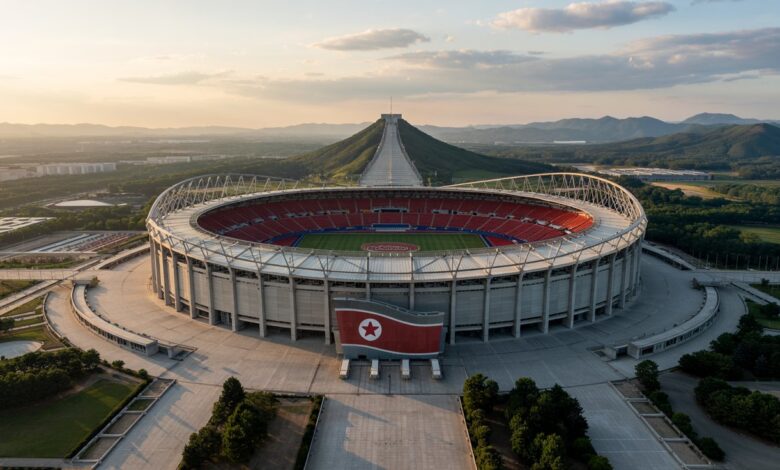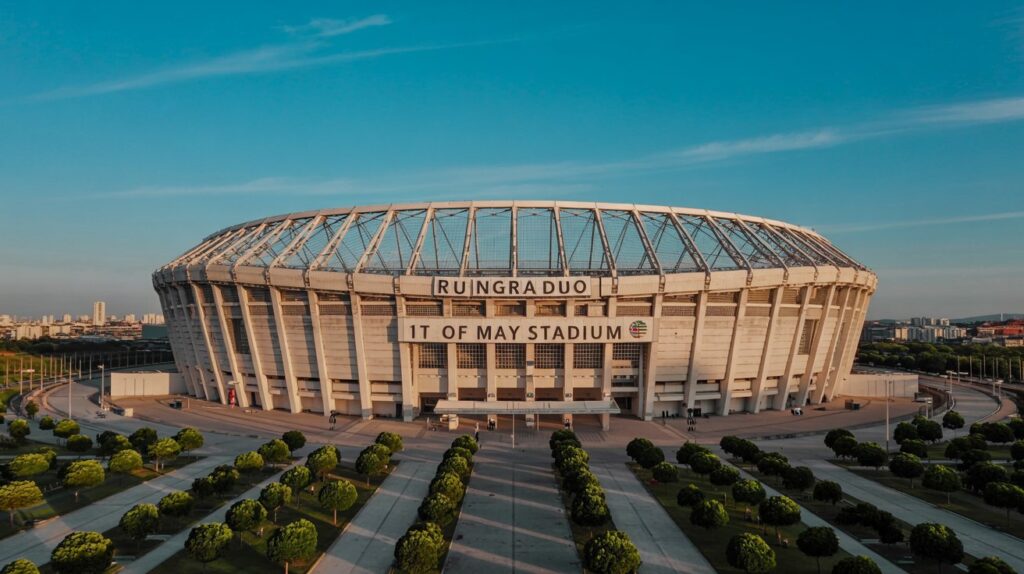Rungrado 1st of May Stadium: The Ultimate Guide to the World’s Largest Stadium

The Rungrado 1st of May Stadium, often referred to as the May Day Stadium, stands as a monumental symbol of North Korea’s ambition, architectural prowess, and cultural pride. Located on Rungra Island in Pyongyang, this colossal multi-purpose venue is the world’s largest stadium by seating capacity, accommodating up to 114,000 spectators. Since its opening on May 1, 1989, it has hosted iconic events, from the Arirang Mass Games to international football matches and historic summits.
Table of Contents
A Brief History of Rungrado 1st of May Stadium
The Rungrado 1st of May Stadium was constructed as a bold response to South Korea’s hosting of the 1988 Seoul Olympics. North Korea, seeking to assert its legitimacy and showcase its capabilities, bid to host the 13th World Festival of Youth and Students in 1989. The stadium, completed in just 2.5 years, was a centerpiece of this effort, becoming the largest in Asia at the time. Its inauguration on May 1, 1989, aligned with International Workers’ Day, reflecting North Korea’s emphasis on labor and unity.
The stadium’s construction was a feat of engineering, covering 20.7 hectares (51 acres) and boasting a total floor space of over 207,000 square meters across eight stories. Its capacity, officially listed at 114,000 after a 2014 renovation, was initially reported as high as 150,000, making it a global record-holder. Today, it remains the second-largest stadium worldwide, surpassed only by India’s Narendra Modi Stadium (132,000 capacity).
Architectural Marvel: Design and Features
The Rungrado 1st of May Stadium is as much an architectural masterpiece as it is a functional venue. Its most striking feature is its scalloped roof, composed of 16 petal-shaped arches arranged in a ring, resembling a magnolia blossom or a parachute. This design, which spans 94,000 square meters and peaks 60 meters above ground, earned first prize at the 1988 International Exhibition of Inventions in Geneva. The roof’s 11,000 tons of steel supports create a visually stunning silhouette that symbolizes North Korea’s cultural and aesthetic values.
Key Features of the Stadium
- Main Pitch: Covers 22,500 square meters, ideal for football, athletics, and large-scale performances.
- Facilities: Includes training areas, locker rooms, swimming pools, a mini-golf course, and 1,300 renovated rooms for various events.
- Modern Amenities: Post-2014 renovations added new changing rooms, physiotherapy suites, a media center, and updated seating, enhancing its appeal for international events.
- Accessibility: Located on Rungra Island in the Taedong River, the stadium is a central landmark in Pyongyang, though access for international visitors is restricted due to North Korea’s tourism policies.
The stadium’s oval shape and concrete arches evoke a lotus blossom, aligning with North Korean symbolism of purity and resilience. Its multi-purpose design supports everything from sports to cultural spectacles, making it a versatile hub for national pride.
Iconic Events Hosted at Rungrado 1st of May Stadium

The stadium’s legacy is defined by its role in hosting some of the world’s most spectacular and unique events. Below are highlights that showcase its global significance.
1. Arirang Mass Games
The Arirang Festival, a gymnastic and artistic extravaganza, is the stadium’s signature event. Featuring over 100,000 performers often double the spectator count it combines synchronized dance, acrobatics, and music to celebrate North Korean history and ideology. Held intermittently since 2002, the Mass Games returned in 2018 after a hiatus and remain a draw for rare foreign visitors. The 2019 performance, “Invincible Socialism,” marked the 70th anniversary of China-North Korea relations, attended by Xi Jinping.
2. Collision in Korea (1995)
In April 1995, the stadium hosted Collision in Korea, the largest professional wrestling pay-per-view event ever, organized by World Championship Wrestling. With reported attendances of 150,000 and 190,000 over two days, it set a record for wrestling events, though some figures are debated due to North Korea’s controlled media. This event highlighted the stadium’s capacity to host international spectacles.
3. Inter-Korean Summit (2018)
In September 2018, South Korean President Moon Jae-in delivered a historic speech alongside Kim Jong Un to 150,000 spectators, emphasizing peace, unification, and cooperation. This moment underscored the stadium’s role as a stage for diplomatic milestones.
4. Football and Athletics
While the North Korean national football team primarily uses the Kim Il-sung Stadium, Rungrado hosts occasional matches, including six group-stage games for the 2018 AFC U-23 Championship qualification in 2017. Its track and field facilities also support athletics, though sports events are secondary to cultural performances.
5. New Year’s Eve Celebrations
Since 2022, the stadium has become the main venue for New Year’s Eve concerts, presided over by Kim Jong Un. These events, blending music and political messaging, reinforce the stadium’s status as a national gathering place.
Cultural and Political Significance

The Rungrado 1st of May Stadium is more than a sports venue it’s a symbol of North Korean identity. Built to rival South Korea’s Olympic Stadium, it embodies the nation’s drive to project strength and legitimacy. Its frequent use for state-sponsored events, like the Arirang Mass Games, reinforces narratives of unity and loyalty to the Kim dynasty. Kim Jong Un’s 2013 pledge to remodel it into “a stadium befitting a highly civilized nation” reflects ongoing efforts to modernize while maintaining its ideological role.
However, the stadium’s grandeur has sparked debate. Critics highlight the cost of maintenance in a resource-scarce country, and its environmental impact has been questioned. Limited access for tourists, due to North Korea’s restrictive policies, adds to its mystique but hinders global engagement.
Conclusion
The Rungrado 1st of May Stadium is a testament to North Korea’s ambition, blending architectural brilliance with cultural and political significance. From its magnolia-inspired design to its role in hosting the Arirang Mass Games and historic summits, it remains a global icon. This guide has explored its history, features, and impact, offering practical insights for sports fans, travelers, and curious readers. Whether you’re fascinated by its scale or intrigued by its role in North Korean culture, the May Day Stadium stands as a powerful symbol of human creativity and national pride.
FAQs
What is the capacity of the Rungrado 1st of May Stadium?
Officially, it holds 114,000 spectators, though earlier reports claimed up to 150,000. It’s the world’s largest stadium by seating capacity
What events are held at the Rungrado 1st of May Stadium?
The stadium hosts the Arirang Mass Games, football matches, athletics, New Year’s Eve concerts, and historic events like the 2018 inter-Korean summit.
Can tourists visit the Rungrado 1st of May Stadium?
Access is limited due to North Korea’s strict tourism policies, but guided tours, often through agencies like Koryo Tours, may include the stadium during Mass Games.




